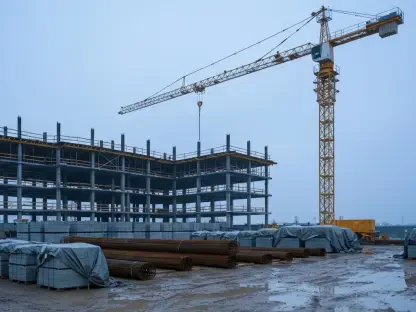The construction industry is known for its inherent risks, yet recent reports indicate a troubling pattern of safety violations. The Occupational Safety and Health Administration (OSHA) has documented numerous infractions in the final quarter of 2024, highlighting widespread non-compliance among construction firms. These violations, particularly those related to falls and trench cave-ins, raise alarm about the industry’s safety practices.
Recurring Safety Violations
Common Infractions
OSHA’s analysis reveals that many construction firms repeatedly commit the same safety infractions. Violations such as the absence of fall protection, improper ladder use, and lack of personal protective equipment (PPE) are alarmingly common. These infractions not only endanger workers but also indicate potential indifference towards regulatory compliance. Construction companies, despite knowing the importance of adhering to these safety protocols, often fall short, resulting in unnecessary risks to their workforce. The recurring nature of these violations raises serious questions about the industry’s commitment to worker safety.
The lack of fall protection is one of the most cited infractions by OSHA. Workers operating at heights without adequate safety measures face tremendous risks, as falls remain one of the leading causes of fatalities in construction. Moreover, improper ladder usage further exacerbates the danger, as it can lead to severe injuries or even death. Another frequent violation is the failure to provide workers with essential PPE, such as hard hats and eye protection. These fundamental safety tools are critical in preventing accidents, and their absence points to a glaring oversight by construction firms.
Worker Training Deficiencies
A significant contributor to these violations is the lack of adequate worker training. Many citations highlighted instances where employees were not properly educated on safety protocols, leading to preventable accidents. Proper training is essential for ensuring that workers understand the hazards they face and the necessary steps to mitigate those risks. When training is insufficient, the likelihood of accidents increases, jeopardizing worker safety and well-being.
This lack of training underscores a deeper issue within the industry regarding the prioritization of worker safety. OSHA’s citations often reveal that workers are not only uninformed about specific safety measures but are also unaware of general safety practices. This gap in knowledge can result in dangerous work environments where hazards are not adequately addressed. Construction firms must prioritize comprehensive and continuous training programs to ensure that all workers are equipped with the knowledge and skills needed to perform their tasks safely.
Falls and Trench Cave-ins
High-Fatality Hazards
Falls and trench cave-ins remain among the deadliest hazards on construction sites. OSHA’s focus on these dangers through national emphasis programs is a direct response to their high fatality rates. The documented cases of workers exposed to fall hazards without proper protection, or working in unprotected trenches, underline the severe risks involved. These specific hazards are particularly concerning due to the catastrophic consequences they can entail, often resulting in severe injuries or fatalities.
The high-risk nature of falls has led OSHA to emphasize the importance of fall protection measures. Workers operating at heights must be equipped with guardrails, safety nets, or harnesses to prevent accidents. Similarly, trench cave-ins pose a significant threat, especially when trenches lack the required supports to ensure stability. OSHA’s focus on these critical areas aims to mitigate the risk of fatalities and promote safer working conditions on construction sites.
Case Examples
Specific cases, such as those involving RRC Home Improvement and Fino Exterior Inc., illustrate the ongoing struggle to enforce safety standards. These companies were cited multiple times for similar violations, emphasizing a disturbing trend of repeated non-compliance. RRC Home Improvement, for instance, faced nearly $330,000 in penalties across three inspections for repeated fall protection violations. Similarly, Fino Exterior Inc. was fined over $300,000 for multiple instances of workers lacking fall protection, with infractions observed across four inspections in 2024.
These examples serve as stark reminders of the need for stringent safety measures. The repeated nature of these violations indicates a systemic problem within certain firms, where safety protocols are not adequately enforced or prioritized. Such cases underscore the importance of robust oversight and the implementation of effective safety practices to prevent repeated infractions and protect workers from harm.
Repeat Offenders
Pattern of Non-Compliance
A notable aspect of OSHA’s citations is the prevalence of repeat offenders. Companies like RRC Home Improvement, fined nearly $330,000 for repeated fall protection violations, showcase a persistent disregard for safety regulations. This pattern suggests that current penalties may not be sufficient to compel compliance. Despite facing significant fines and citations, these firms continue to engage in unsafe practices, endangering their workers and highlighting a concerning trend of non-compliance.
The frequency of repeat violations raises questions about the effectiveness of OSHA’s enforcement strategies. When companies repeatedly violate safety standards, it indicates a fundamental issue in their approach to workplace safety. These firms often fail to implement corrective actions, allowing the same hazards to persist across multiple inspections. This ongoing issue highlights the need for more stringent penalties and stronger enforcement measures to compel companies to prioritize worker safety.
Increased Penalties for Repeat Violators
OSHA often imposes heftier initial penalties on firms with a history of violations. However, these fines are frequently contested or settled for reduced amounts, potentially undermining their deterrent effect. The ongoing issue of repeat violations highlights the necessity for more effective enforcement strategies. When significant penalties are reduced through settlements, the financial impact on offending companies is lessened, which may not provide a strong enough incentive for them to change their practices.
To address this issue, OSHA must consider adopting more robust enforcement mechanisms that ensure penalties are sufficiently impactful. This could include stricter criteria for reducing fines during settlements or the implementation of additional oversight measures for repeat offenders. By enhancing the enforcement process, OSHA can better ensure that companies take their safety obligations seriously and make the necessary changes to protect their workforce.
OSHA’s Enforcement and Settlement Process
Citation Issuance
The process of issuing citations involves meticulous inspections and documentation of violations. OSHA’s goal is to publicize these citations to demonstrate regulatory authority and draw attention to common safety issues. Through thorough evaluations, inspectors identify hazards and document compliance failures, providing a clear record of the infractions observed. However, the impact of these citations is often mitigated during the settlement phase, where companies negotiate for reduced penalties.
Inspections are a critical component of OSHA’s enforcement strategy, as they allow the agency to identify and address safety violations directly. By publicizing citations, OSHA aims to raise awareness about prevalent safety issues and encourage firms to improve their practices. Nonetheless, the effectiveness of this approach depends on the consistency and rigor of the enforcement process, as well as the willingness of companies to comply with safety regulations.
Negotiation and Settlement
Many firms opt to contest or negotiate the fines imposed by OSHA. While initial penalties may be substantial, settlements often reduce the final amount paid by the offending companies. This practice raises questions about the overall effectiveness of OSHA’s enforcement in achieving lasting compliance. When companies successfully negotiate lower fines, the deterrent effect of the penalties is diminished, potentially allowing unsafe practices to continue.
The negotiation and settlement process, while important for resolving disputes, must strike a balance between fairness and enforcement. OSHA needs to ensure that settlements do not undermine the primary goal of improving workplace safety. This could involve setting stricter criteria for reducing fines or implementing additional measures to verify that companies have made meaningful changes to their safety practices. By maintaining a rigorous approach to settlements, OSHA can better ensure that its enforcement efforts lead to genuine improvements in worker safety.
Severe Violators Enforcement Program (SVEP)
Targeting Persistent Offenders
OSHA’s Severe Violators Enforcement Program (SVEP) targets employers who willfully and repeatedly disregard worker safety. Inclusion in SVEP subjects companies to increased scrutiny and stiffer penalties. Firms like RRC Home Improvement, listed in the SVEP, face heightened oversight as a deterrent against ongoing safety violations. The program aims to hold the most egregious offenders accountable and encourage them to prioritize worker safety.
SVEP targets firms with a history of severe violations, applying additional pressure to ensure compliance. Companies listed in the program are subject to more frequent inspections and greater regulatory oversight, which serves as both a deterrent and a means of monitoring their commitment to improving safety standards. This heightened scrutiny aims to reduce the incidence of repeat violations and promote a culture of safety within the industry.
Impact of SVEP
The construction industry is notorious for its inherent risks, and recent findings shed light on a disturbing trend of safety breaches. The Occupational Safety and Health Administration (OSHA) has reported numerous violations during the last quarter of 2024, exposing a significant level of non-compliance among construction companies. These infractions, mainly revolving around falls and trench cave-ins, raise serious concerns about the standard safety practices within the industry.
Construction sites are inherently dangerous environments, which is why adherence to safety regulations is crucial. However, the recent spike in OSHA-documented violations suggests that many firms are falling short. Falls are one of the leading causes of injury and death in construction, indicating a worrisome neglect of basic safety measures like harnessing and secured scaffolding. Trench cave-ins, another common violation, highlight a disregard for proper shoring and protective systems that are essential to safeguarding workers in excavation sites.
The consequences of these safety lapses are severe, risking the lives and well-being of construction workers daily. Despite existing regulations and safety protocols, the repeated offenses suggest that enforcement and training may be lacking. It is imperative for the industry to revisit and strengthen its commitment to safety to protect its workforce and maintain ethical standards. The pattern of violations not only undermines worker safety but also affects the industry’s reputation and trustworthiness.









